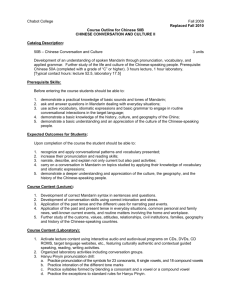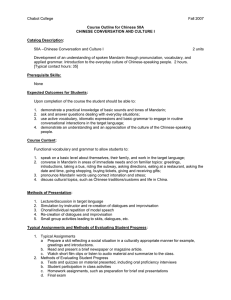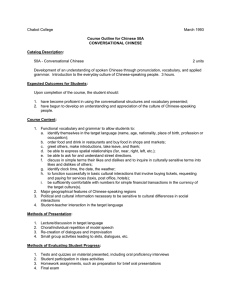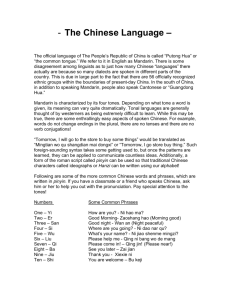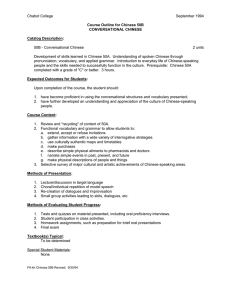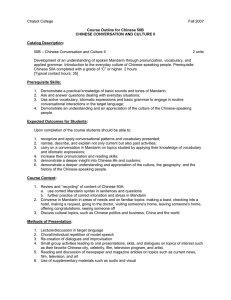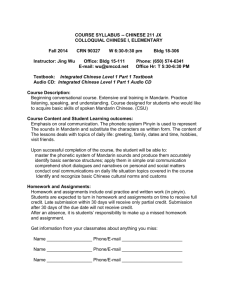Chabot College Fall 2009 Replaced Fall 2010
advertisement
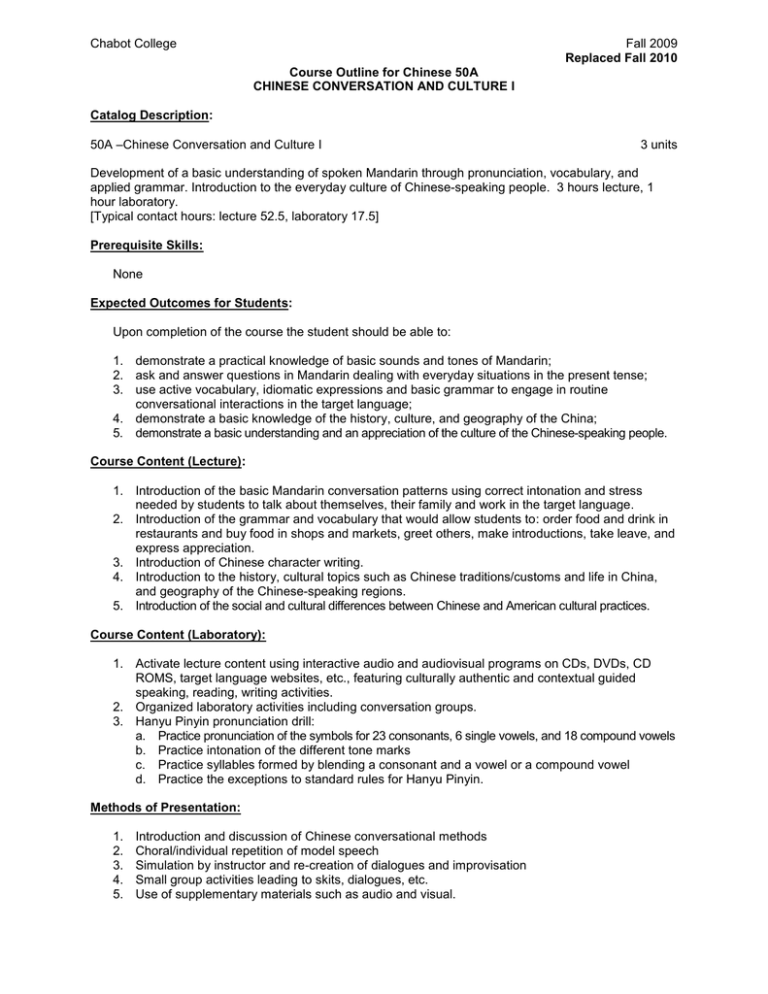
Chabot College Fall 2009 Replaced Fall 2010 Course Outline for Chinese 50A CHINESE CONVERSATION AND CULTURE I Catalog Description: 50A –Chinese Conversation and Culture I 3 units Development of a basic understanding of spoken Mandarin through pronunciation, vocabulary, and applied grammar. Introduction to the everyday culture of Chinese-speaking people. 3 hours lecture, 1 hour laboratory. [Typical contact hours: lecture 52.5, laboratory 17.5] Prerequisite Skills: None Expected Outcomes for Students: Upon completion of the course the student should be able to: 1. demonstrate a practical knowledge of basic sounds and tones of Mandarin; 2. ask and answer questions in Mandarin dealing with everyday situations in the present tense; 3. use active vocabulary, idiomatic expressions and basic grammar to engage in routine conversational interactions in the target language; 4. demonstrate a basic knowledge of the history, culture, and geography of the China; 5. demonstrate a basic understanding and an appreciation of the culture of the Chinese-speaking people. Course Content (Lecture): 1. Introduction of the basic Mandarin conversation patterns using correct intonation and stress needed by students to talk about themselves, their family and work in the target language. 2. Introduction of the grammar and vocabulary that would allow students to: order food and drink in restaurants and buy food in shops and markets, greet others, make introductions, take leave, and express appreciation. 3. Introduction of Chinese character writing. 4. Introduction to the history, cultural topics such as Chinese traditions/customs and life in China, and geography of the Chinese-speaking regions. 5. Introduction of the social and cultural differences between Chinese and American cultural practices. Course Content (Laboratory): 1. Activate lecture content using interactive audio and audiovisual programs on CDs, DVDs, CD ROMS, target language websites, etc., featuring culturally authentic and contextual guided speaking, reading, writing activities. 2. Organized laboratory activities including conversation groups. 3. Hanyu Pinyin pronunciation drill: a. Practice pronunciation of the symbols for 23 consonants, 6 single vowels, and 18 compound vowels b. Practice intonation of the different tone marks c. Practice syllables formed by blending a consonant and a vowel or a compound vowel d. Practice the exceptions to standard rules for Hanyu Pinyin. Methods of Presentation: 1. 2. 3. 4. 5. Introduction and discussion of Chinese conversational methods Choral/individual repetition of model speech Simulation by instructor and re-creation of dialogues and improvisation Small group activities leading to skits, dialogues, etc. Use of supplementary materials such as audio and visual. Chabot College Course Outline for Chinese 50A, Page 2 Fall 2009 Assignments and Methods of Evaluating Student Progress: 1. Typical Assignments: a. Prepare a 5-minute skit reflecting a social situation in a culturally appropriate manner for example, greetings and introductions. b. Read and present a brief one-page newspaper or magazine article. Good examples of newspapers and magazines can be found at the library and for online articles you can find them at the World Languages department website. c. Watch short 30-minute film clips or listen to audio material that can be found at our Learning Center and summarize to the class. 2. Methods of Evaluating Student Progress a. Tests and quizzes on material presented, including oral proficiency interviews b. Student participation in class activities c. Homework assignments, such as preparation for brief oral presentations d. Final examination Textbook(s) Typical: Integrated Chinese, Tao-Chung Yao, 2nd edition, Chen & Tsui Company: Boston, 2008. Workbook /Character Workbook/Audio CDs Lab Version, 3rd edition, Level 1, Part 1, to accompany Integrated Chinese, Chen & Tsui Company: Boston, 2008. Special Student Materials: None curriculum 0809 dk 11/13/2008
